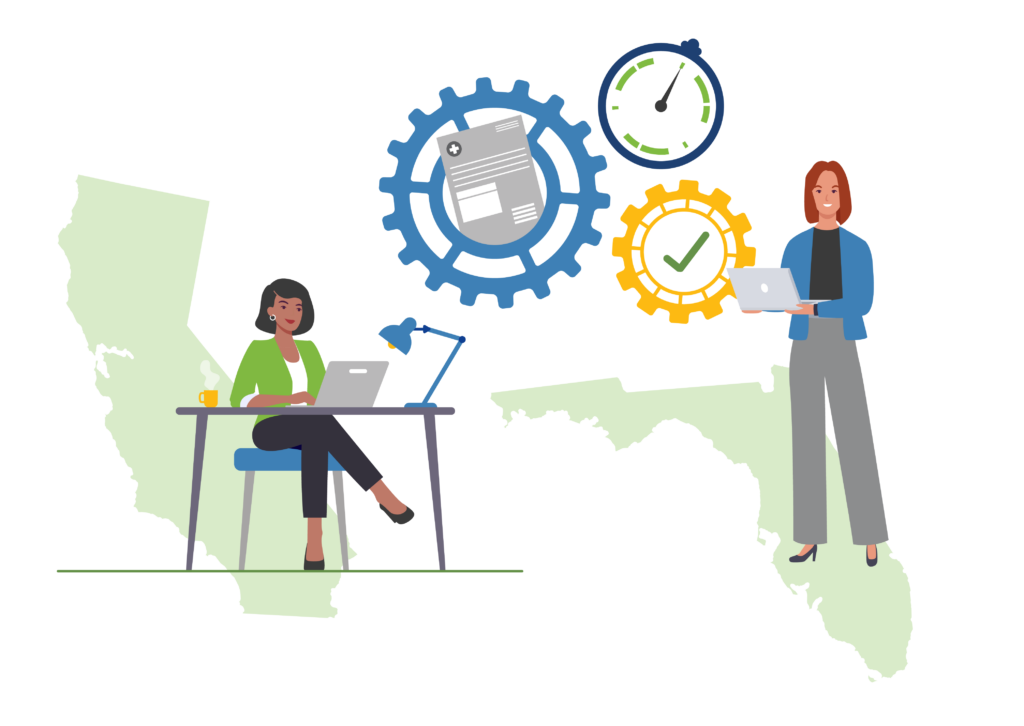Workers’ compensation programs in the United States are state regulated, meaning that the laws are determined by each state legislative body and implemented by a state agency. Although revenue cycle teams in different states have similar experiences — after all, revenue cycle is revenue cycle no matter where you are — the filing and appeals process for workers’ compensation claims can vary significantly from one state to the other.
Let’s look at two fictional billing specialists — Allison in California and Sarah in Florida — and see how they navigate the complexities of workers’ compensation claims in their respective states. (Keep in mind that these two states are used only as an example of variations in the workers’ compensation process!).
California Chronicles: Stringent Guidelines Lead to Stressful Days
Allison works on a revenue cycle team for a large hospital in San Diego. Her hospital handles all claims processing — including workers’ compensation claims — in house. Although Allison works on a variety of claims, her primary focus is on workers’ compensation claims. This means she must stay up to date on the guidelines and fee schedules set forth by the Division of Workers Compensation (DWC), a division of the State of California Department of Industrial Relations.
It’s Monday morning. On Saturday, a man visited the emergency room after being burned by a chemical that splashed on his skin at the factory where he works. Allison’s day begins by gathering all relevant information about the injured worker, his employer and the nature of the injury. She is glad to know the doctor who treated the injured worker has already completed and submitted the “Doctor’s First Report of Occupational Injury or Illness—Form 5021,” a form that must be filed within five working days of the injured worker’s initial examination.
Next, Allison carefully reviews the medical records associated with the injured worker’s visit to the hospital. She must verify that all procedures, treatments and services provided are accurately documented and coded according to California’s workers’ compensation regulations. However, navigating these regulations and ensuring accurate coding can be time-consuming and prone to errors. Simultaneously, she also reaches out to the injured worker’s employer to ensure they have submitted the necessary paperwork and documentation from their end.
Allison then begins the process of submitting the claim to the workers’ compensation insurance carrier. Thankfully, California allows for electronic processing. So, what are the workers’ comp claim filing rules in California? According to DWC guidelines, a claim must include the following when filed:
- The correct uniform billing form and format for the type of healthcare provider
- The correct uniform billing codes for the applicable portion of the Official Medical Fee Schedule (OMFS) under which the services are being billed, including the correct ICD code
- The uniform billing form, completed according to the requirements specified for each format in Appendix A and/or the Companion Guide
- Required reports and supporting documentation, including a doctor’s first report of occupational injury; progress reports or their narrative equivalents; and descriptive reports of the procedure, medication or treatment
Allison navigates through the electronic portal, entering data and information with precision, because she knows that even the smallest error could lead to delays in reimbursement or — worse — a claim denial.
The process is tedious and labor-intensive, and those hours were spent on just one claim. Allison still has more workers’ compensation claims to tackle this week — and it’s only Monday afternoon.
Florida Files: Pre-authorization Requirement Complicates the Process
Meet Sarah, a medical biller at a large hospital in Tampa, Florida. Sarah has years of experience in complex claims management and handling workers’ compensation claims — but that doesn’t mean the process isn’t still difficult.
One morning, Sarah’s day takes an unexpected turn as she receives a new case, a patient who was injured at work. Let’s call him Michael. Michael’s case is complicated: He suffered a serious injury, falling off a ladder and breaking his femur, which required emergency surgery and a two-day inpatient stay.
So, what are the workers’ comp claim filing rules in Florida? Sarah knows that Florida’s workers’ compensation laws do not require prior authorization for emergency care at the time care is rendered — but an inpatient hospital stay does require pre-authorization. She understands, however, that the insurance carrier must be notified by the close of the third business day after it has rendered care. It is also critically important to meticulously document the prior authorization requests for the inpatient stay in the injured worker’s medical records and the hospital’s financial records in order to receive reimbursement.
As Sarah begins to navigate Michael’s case, she encounters the first challenge: identifying his workers’ compensation insurer. Michael provided only the name and phone number of his manager. Sarah contacts Michael’s employer, navigating phone trees and red tape in her quest for answers. After several calls and countless transfers, she finally reaches someone who can provide the information she needs. It’s a time-consuming and exhausting way to spend the morning for her, and an expensive morning for her employer.
Next comes the daunting task of obtaining pre-authorization for Michael’s inpatient hospital stay. Sarah knows this step is important for ensuring reimbursement for the services provided. She reaches out to the insurance carrier, navigating the maze of phone prompts and paperwork to submit the necessary documentation. At the same time, she is working to ensure the emergency surgery is properly documented and coded for reimbursement. She meticulously documents every detail of the procedure to ensure compliance with Florida’s workers’ compensation regulations.
Common Threads and Anomalies
So, what if your provider organization operates only in, say, Kentucky and Tennessee? Is there a broader takeaway from this tale of two claims in California or Florida?
The answer is yes. The common thread running through workers’ compensation across the board is its potential for complexity and tedium. Complications can include various anomalies — in Texas, for example, private employers can opt out of workers’ compensation, an option available in no other state. Such factors can unduly tax a small revenue cycle team that already has its hands full processing the more prevalent and routine claims such as Medicaid and Medicare.
When a workplace injury occurs, it can create stress not only for the patient but also for the medical biller, whose organization deserves to be paid for the work it has done. The situation calls for empathy for both biller and patient. It also calls for a thorough understanding of the challenges and potential pitfalls standing between accident and treatment, or between treatment and reimbursement.
Workers’ compensation is right in the center of EnableComp’s wheelhouse. That’s where we got our start, and that’s one of the key areas where we are making a difference in the bottom lines of hundreds of clients. We know the rules inside and out, and our vast database, driven by our E360 RCM™ intelligent automation platform, quickly makes sense of complicated situations and expedites proper payment.
Learn More: Download Our Workers’ Comp E-Book
Complex claims management — specifically, workers’ comp claims — doesn’t have to be complex. Download our free e-book Surviving Workers’ Compensation: A Healthcare Provider’s Guide to the Process and Its Risks. Or contact us to schedule a consultation.





























